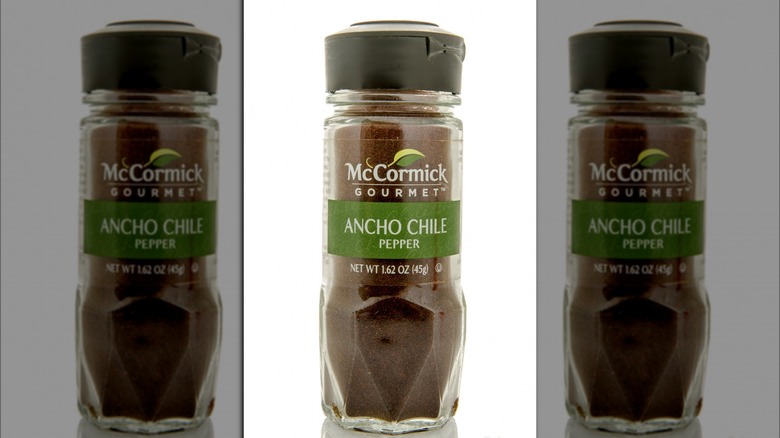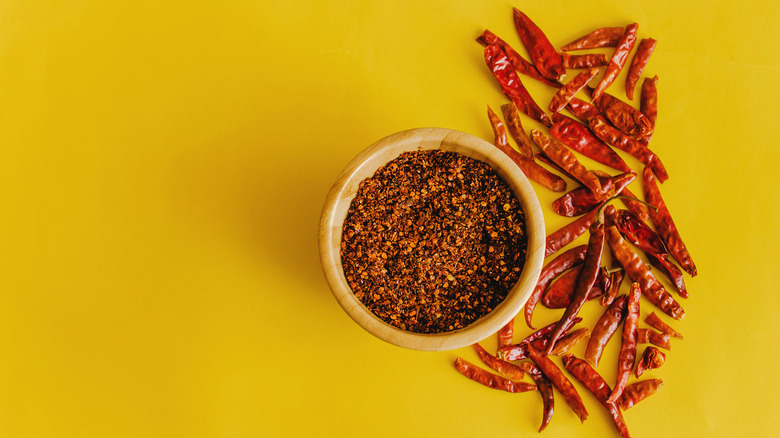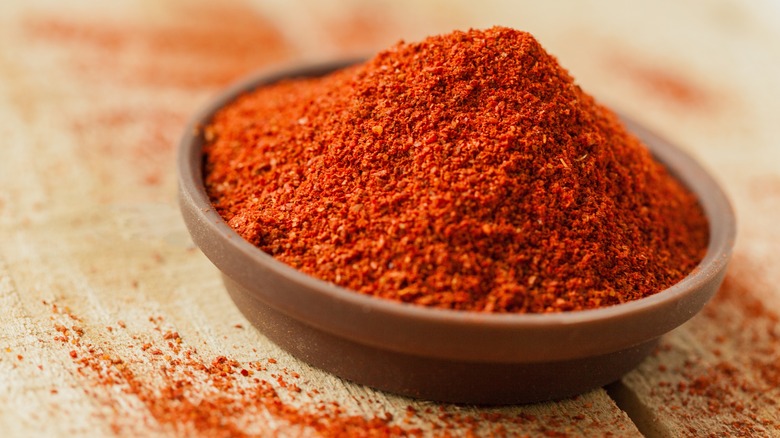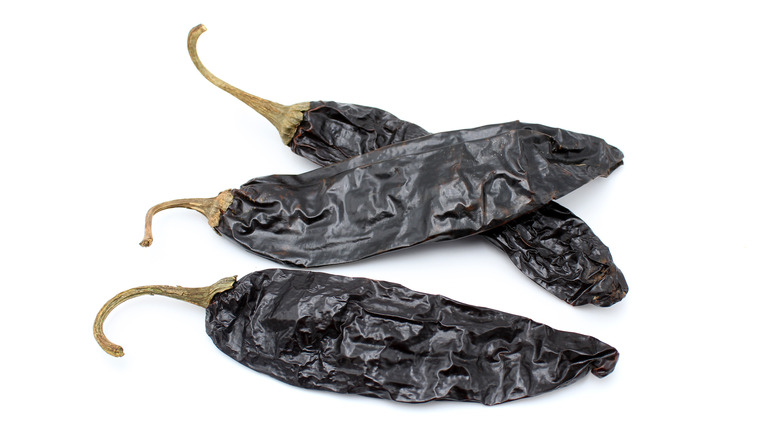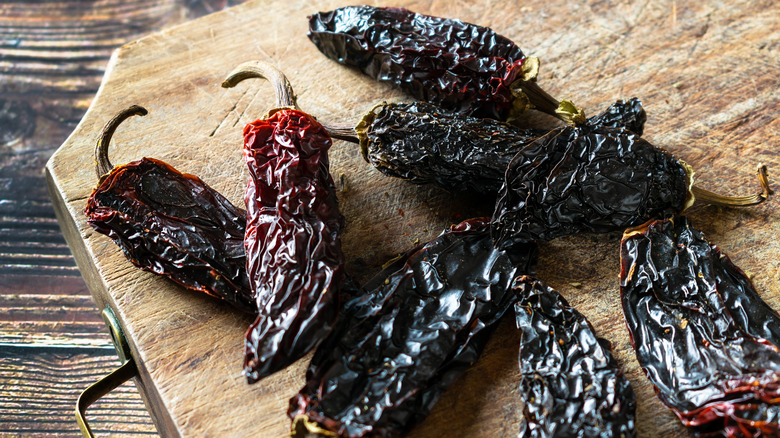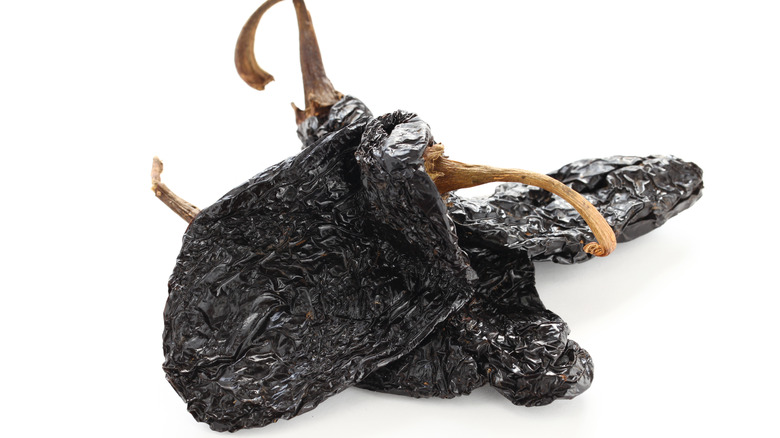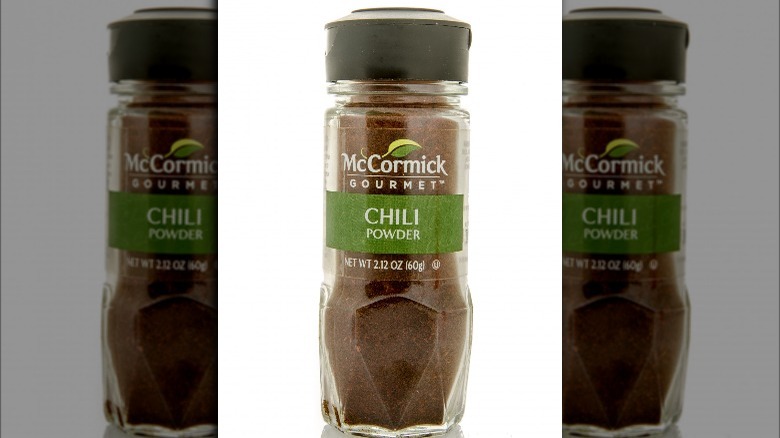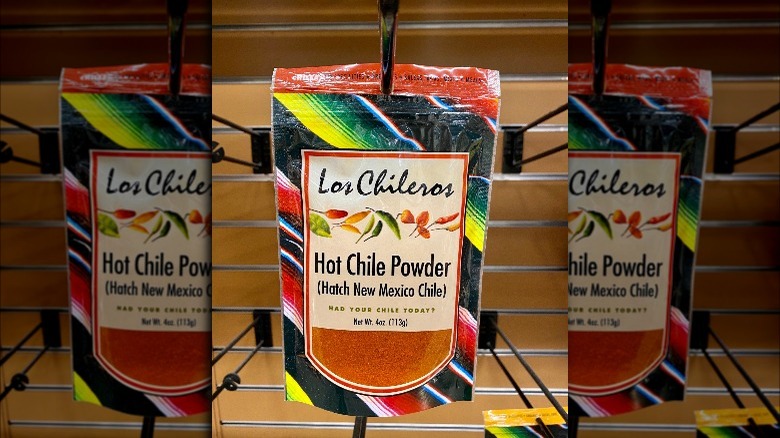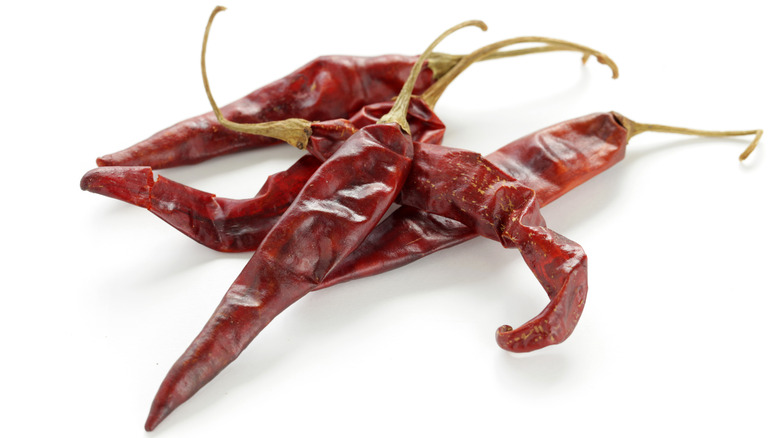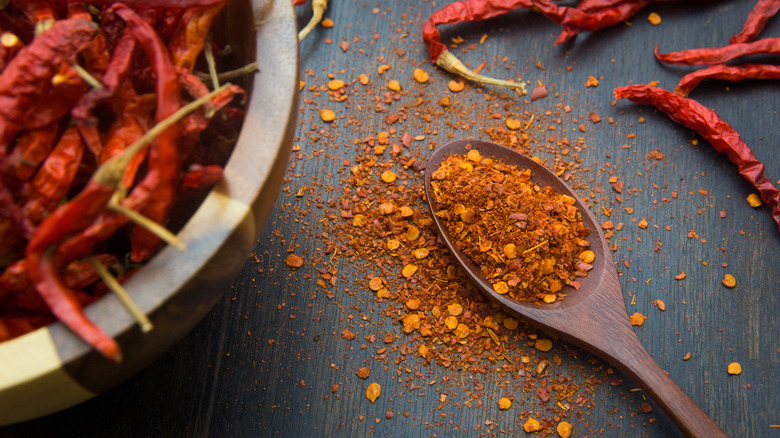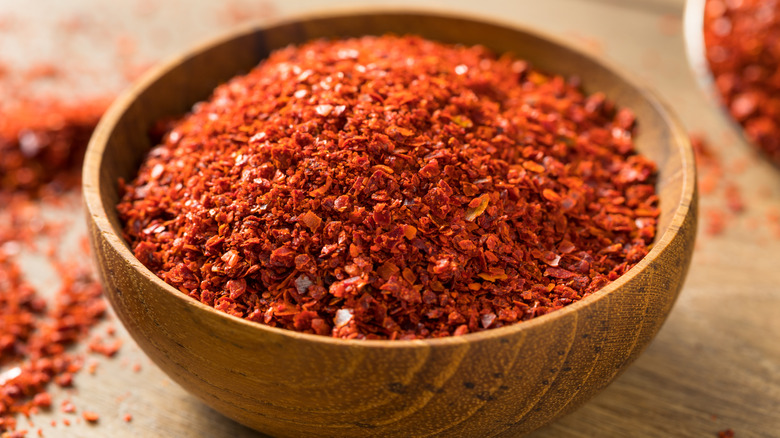10 Best Substitutes For Ancho Chile Powder
A tablespoon of this. A dash of that. You're well on your way to preparing that mouth-watering rub, marinade, or other well-seasoned dish you've been dying to try. Then you see it: Ancho chile powder. You've read the recipe dozens of times, but you're just now registering that this particular chile is missing from your pantry. Don't ditch the dish — you probably have plenty of acceptable substitutes at your fingertips. Before you grab the first spice you see, though, dig a little deeper into the flavor profile of ancho chile to ensure that you select the best match.
According to Gourmet Sleuth, ancho chile powder is a moderate-heat substance ground from whole ancho chiles, the name for dried poblano peppers. The grinding of chiles in general dates back to the Aztecs, who dried fresh peppers for preservation and used them as a flavoring in dishes such as drinking chocolate. These days, burgundy-colored, mildly flavored ancho chile powder is one of the most used ingredients in Mexican cooking, and its slightly raisiny flavor pairs well with pork and beef. Although traditionally used in sauces, soups, and stews, ancho powder is also found in everything from chocolates to cakes. Finally, ancho chiles rate around 1,250 on the Scoville heat index, the mildest section of the scale, according to Pepper Scale. Here's what to use when you find yourself ancho-less and in need of subtle heat.
1. Guajillo Chile Powder
Curious Cuisiniere recommends guajillo chile powder as a suitable substitute for ancho chile powder. With a median of 3,750 Scoville heat units, guajillos are just a smidge hotter than the peppers used to make ancho chile powder (via Pepper Scale). Deriving from the second most popular chile in Mexico after ancho chiles, guajillo chile powder has a tangy, pleasantly sharp taste with hints of berry and pine (via Savory Spice Shop). Guajillo gets its Spanish name from the shape of the pepper, which resembles a "little gourd."
Guajillo powder can be added to just about any dish that calls for chiles, but it's traditionally used in Mexican and Southwestern cuisine, flavoring everything from mole sauces to stews and braises. Word to the wise: While its heat is mild, its flavor is distinct.
You can use a one-to-one swap for ancho chile powder in recipes, but be sure to taste as you go and remember that a little guajillo goes a long way so you don't overdo it.
2. Paprika
Pepper Scale says that paprika is a solid choice 一 and a good heat match 一 to replace ancho chile powder. If it's available, select mild paprika; it may be slightly sweeter than ancho chile powder, but it works in a pinch.
The national spice of Hungary, according to Jessica Gavin, paprika is derived from Capsicum annuum, a genus that includes red peppers, bell pepper, and chile peppers. Different blends of the spice are designated with grades that describe the heat and flavor profile. Sweet paprika (usually labeled "paprika") is more subtle than spicy, while smoked paprika has a touch of charred flavor. Sixteenth-century Spanish explorers who visited what is now central Mexico, where paprika was originally cultivated, brought the spice back to their country, according to MasterClass. From there, its popularity spread to Asia, Africa, and other parts of Europe.
Use a one-to-one swap in recipes, and if you need more of a kick, add a dash of cayenne pepper as well.
3. Pasilla Chile Powder
Pasilla chile powder is made from dried chilaca peppers, which have earthy undertones that work particularly well in mole sauces. Spiceography recommends the powder as a stand-in for ancho chile powder because the two ingredients share common traits, including their relatively mild heat level (although anchos can be a little hotter). On that note, make sure that you don't confuse the two while shopping; Chili Pepper Madness says that ancho chile powder is often mislabeled as pasilla powder at U.S. grocers.
According to Spice Jungle, ground pasilla chile powder ranges in color from deep purple to black. It boasts a dark, rich — almost chocolaty — flavor with hints of dried fruit, like prunes and raisins. This spice is less of a background note and more of a star ingredient, so use it sparingly if your dish only needs a subtle chile flavor. In addition to complementing mole sauces and bean-centric dishes, it adds depth to compound butters to be used on anything from bread to vegetables.
Use pasilla powder as a one-to-one swap for ancho powder in recipes.
4. Chipotle Powder
Pepper Scale classifies chipotle powder, which is readily available in most major grocery stores, as among the easiest-to-find substitutes for ancho chile powder. Made from dried, smoked jalapeños, chipotle powder has a Scoville heat unit rating of 2,500 to 8,000. While this is certainly spicier than its ancho relative, it can work as an alternative when necessary; just use a light hand and do plenty of taste testing while cooking.
According to Chili Pepper Madness, the word "chipotle" comes from the Nahuatl word "chilpoctli" which means "smoked chile." When charred and crushed, these powdered jalapeños offer earthy funkiness to both traditional Mexican dishes and Southwestern or Tex-Mex favorites. Use it any time you need ancho, but especially for meat or seafood, as savory proteins benefit from this common seasoning. It's also ideal as a quick flavor enhancer for any filling in tacos, burritos, enchiladas, quesadillas, and more.
Determine how hot your chipotle powder is before cooking: If it's mild, use it as a one-to-one swap for ancho chile powder. If it's hotter, divide the amount in half.
5. Mulato Pepper Powder
Pepper Scale explains that the mulato pepper has a darker color, more full-bodied flavor, and higher — sometimes double or triple — heat index rating than its ancho relative for a pretty simple reason. These more intense qualities are thanks to its longer maturation process; the longer a chile is left on the vine, the more its capsaicin develops and the more potent it becomes.
Both ancho and mulato peppers are dried versions of poblanos, and both are commonly used whole, chopped, or powdered in Mexican dishes like moles and stews. Mulatos, however, contain notes of licorice and chocolate, which is why they are sometimes incorporated into sweeter dishes and desserts to add a pop of tingly heat. Use the powdered kind as a one-to-one swap for ancho chile powder if you ever want to make a chile-flavored ice cream or baked good.
6. Chili Powder
If you decide to substitute chili powder for ancho chile powder, be sure to note the difference between the spellings of chili and chile. As Bon Appétit explains, one letter makes a world of difference. Regardless of the variety, chile (with an e) powder is made from ground dried chiles, with few or no additives. Each type is named for its pepper base — ancho, guajillo, mulato, etc. Chili (with an i) powder is a seasoning made of dried, crushed chiles plus other ingredients like oregano, paprika, pepper, cumin, garlic powder, onion powder, and salt.
While you could use chili powder on its own in place of ancho chile powder, a combination of chili powder mixed with a touch of crushed red pepper works even better, according to Cooking Light. If a recipe calls for 1 teaspoon of ancho chile powder, for example, replace it with 1 teaspoon of chili powder and ¼ teaspoon of crushed red pepper to make up for any lost heat.
7. New Mexico Chile Powder
New Mexico chile powder is made entirely from dried chiles (unlike chili powder which contains added spices), says Fine Cooking, and boasts an earthy flavor with subtle hints of fruitiness. It's a common ingredient in the southwestern state's spins on enchiladas, chile sauces, and ground beef taco filling.
New Mexico chiles grow to about six inches long and change from green to red as they ripen, according to Bon Appétit, and are used for cooking at all stages of development, as well as fresh and chopped or dried and powdered. Varieties include Anaheim, Chile Colorado, and Hatch, among others. When fresh, the chiles are usually mild, while the powdered versions can be a little bit hotter.
Gourmet Sleuth suggests replacing ancho chile powder with an equal amount of New Mexico chile powder, noting that discerning palates may pick up on a slight difference in flavor but should appreciate the on-point heat match.
8. Chile de Árbol Powder
Gourmet Sleuth lists chile de árbol powder as a reasonably sufficient substitute for ancho chile powder. These small but mighty, long, and thin chiles were first documented in the 1500s by a Spanish explorer in what is now known as Latin America, and today they are used mostly in the Jalisco state of Mexico but also in Southeast Asia (via Spiceography). You might also know these chiles as bird's eye peppers, as that's what they're called in Thailand.
Chiles de árbol are rated moderately hot with a Scoville rating of 10,000 to 30,000 units. Their flavor profile is bright and clean with mild herbal tones, sort of like an extra hot bell pepper, and would pair well with lighter, vegetable-based preparations.
The powdered variety packs a punch of heat — it's even suggested as a suitable alternative to cayenne pepper in some recipes — so try a one-to-one swap while tasting as you go.
9. Cayenne Pepper
You're likely already familiar with finely ground cayenne pepper. You may know a bit less, though, about its source, which is a small, skinny, and lengthy chile that's quite hot. Really, consider this: Cayenne peppers are the only ingredient, other than salt and vinegar, in Tabasco sauce, according to the company website.
Because cayenne is so much more potent than ancho, Leaf.tv suggests combining it with New Mexico chile powder or pasilla powder when using it as a substitute for ancho chile powder. Part of the Capsicum annuum family of plants, cayenne pepper products are commonly used in Creole, Indian, Thai, Chinese, and Korean cooking, and their popularity means they can be found in stores and kitchen cabinets all over the world. According to Spiceography, they originated in French Guiana off the northeast coast of South America.
Spiceography pegs cayenne's heat rating at 30,000 to 50,000 units on the Scoville heat index, so if you choose to sub it in for ancho chile powder, do so with a gentle touch, starting with about a quarter of the amount required and tasting from there.
10. Gochugaru
This Korean chile powder is a blend of fruity, smoky, and sweet flavors all rolled into one. If you've ever had kimchi, you'll recognize its flavor; it's the ingredient that gives the staple Korean dish its heat and color. If you're spice-averse, don't worry: Bon Appétit describes gochugaru as a "gateway" chile flake due to its benign heat.
While it's been a staple in Korean kitchens for ages, gochugaru is gaining a new following among cooks who add it to sauces for steaks and short ribs. It's also tasty spooned over popcorn, blended into dips, and sprinkled on toast. Bon Appétit advises looking for packages of gochugaru that clearly state "sun-dried" (taekyung or taeyangcho in Korean), a sign of higher quality. The seasoning is readily available in Asian grocery stores and some specialty markets.
Gochugaru is about four times as spicy as ancho chile powder (via Pepper Scale), so start by using just a quarter of the amount required in a recipe.
